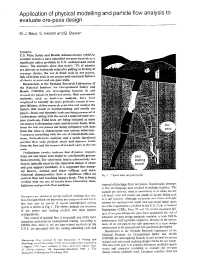Mining Publication: Application of Physical Modelling and Particle Flow Analysis to Evaluate Ore-pass Design
Original creation date: January 1997
U.S. Mine Safety and Health Administration (MSHA) accident statistics have identified ore-pass hazards as a significant safety problem in U.S. underground metal mines. The statistics show that nearly 75% of injuries are directly or indirectly related to pulling or freeing of ore-pass chutes, the use of hand tools in ore passes, falls of broken rock in ore passes and structural failures of chutes or gates and ore-pass walls. Researchers at the Spokane Research Laboratory of the National Institute for Occupational Safety and Health (NIOSH) are investigating hazards in and around ore passes in hard rock mines. Risk assessment methods, such as fault-tree analysis, have been employed to identify the most probable causes of ore-pass failures, define research priorities and analyze the factors that result in malfunctioning and unsafe ore passes. Static and dynamic loads are being measured in a laboratory setting with the use of a reduced-scale ore-pass mock-up. Field tests are being initiated in mine ore passes to determine static and dynamic loads. Data from the test ore passes are being compared with data from the mine to characterize true system behavior. Computer modelling with the use of closed-form solutions, finite-element analyses and a newly developed particle flow code predicts static and dynamic loads from the flow and the impact or ore and waste in the ore pass. Preliminary results indicate that dynamic impacts from ore and waste rock might be considerably greater than expected. The total static load is substantially less than is typically used for the structural design of chute and gate support members. It is suggested that damping factors, normal and shear stiffness and mass frictional characteristics have a significant effect on particle flow and resulting impact loads. This is being verified with the use of results from laboratory tests, field tests and particle flow analyses.
Authors: MJ Beus, SR Iverson, BM Stewart
Peer Reviewed Journal Article - January 1997
NIOSHTIC2 Number: 20000174
Inst Min Metall, Trans, Sect A: Min Ind, 1997 Sep 106():A110-A117
See Also
- Analysis of Multiple Seam Stability
- Determination of Sound Exposures (DOSES): Software Manual and Implementation Guide
- Evaluating Portable Infrared Spectrometers for Measuring the Silica Content of Coal Dust
- Methane Diffusion Parameters for Sized Coal Particles: A Measuring Apparatus and Some Preliminary Results
- Modeling and Data Analysis of 50 to 5000 kHz Radio Wave Propagation in Coal Mines
- Safety Considerations for Transport of Ore and Waste in Underground Ore Passes
- Task Analysis
- Technology News 458 - Development of a Research Facility to Improve Mine Hoisting and Ore Pass Safety
- Technology News 482 - Ground Support Safety Training Video
- Technology News 536 - NIOSH Develops New Software to Analyze and Reduce Noise Exposure
- Content source: National Institute for Occupational Safety and Health, Mining Program


 ShareCompartir
ShareCompartir
